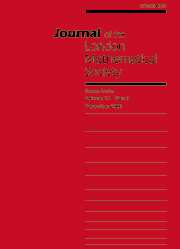Crossref Citations
This article has been cited by the following publications. This list is generated based on data provided by
Crossref.
Anstee, R.P.
and
Keevash, Peter
2006.
Pairwise intersections and forbidden configurations.
European Journal of Combinatorics,
Vol. 27,
Issue. 8,
p.
1235.
Balogh, József
2006.
A remark on the number of edge colorings of graphs.
European Journal of Combinatorics,
Vol. 27,
Issue. 4,
p.
565.
LEFMANN, HANNO
PERSON, YURY
RÖDL, VOJTĚCH
and
SCHACHT, MATHIAS
2009.
On Colourings of Hypergraphs Without Monochromatic Fano Planes.
Combinatorics, Probability and Computing,
Vol. 18,
Issue. 5,
p.
803.
Hoppen, C.
Kohayakawa, Y.
and
Lefmann, H.
2009.
Kneser Colorings of Uniform Hypergraphs.
Electronic Notes in Discrete Mathematics,
Vol. 34,
Issue. ,
p.
219.
Hoppen, C.
Kohayakawa, Y.
and
Lefmann, H.
2011.
Edge colorings of graphs avoiding some fixed monochromatic subgraph with linear Turán number.
Electronic Notes in Discrete Mathematics,
Vol. 38,
Issue. ,
p.
469.
Hoppen, Carlos
Kohayakawa, Yoshiharu
and
Lefmann, Hanno
2012.
Hypergraphs with many Kneser colorings.
European Journal of Combinatorics,
Vol. 33,
Issue. 5,
p.
816.
HOPPEN, CARLOS
KOHAYAKAWA, YOSHIHARU
and
LEFMANN, HANNO
2012.
Edge Colourings of Graphs Avoiding Monochromatic Matchings of a Given Size.
Combinatorics, Probability and Computing,
Vol. 21,
Issue. 1-2,
p.
203.
Lefmann, Hanno
and
Person, Yury
2013.
Exact Results on the Number of Restricted Edge Colorings for Some Families of Linear Hypergraphs.
Journal of Graph Theory,
Vol. 73,
Issue. 1,
p.
1.
Hoppen, Carlos
Kohayakawa, Yoshiharu
and
Lefmann, Hanno
2014.
Edge-colorings of graphs avoiding fixed monochromatic subgraphs with linear Turán number.
European Journal of Combinatorics,
Vol. 35,
Issue. ,
p.
354.
Hoppen, Carlos
Lefmann, Hanno
Odermann, Knut
and
Sanches, Juliana
2015.
Edge-colorings avoiding fixed rainbow stars.
Electronic Notes in Discrete Mathematics,
Vol. 50,
Issue. ,
p.
275.
Hoppen, Carlos
Kohayakawa, Yoshiharu
and
Lefmann, Hanno
2015.
Edge-colorings of uniform hypergraphs avoiding monochromatic matchings.
Discrete Mathematics,
Vol. 338,
Issue. 2,
p.
262.
Hoppen, Carlos
Lefmann, Hanno
and
Odermann, Knut
2015.
A rainbow Erdős-Rothschild problem.
Electronic Notes in Discrete Mathematics,
Vol. 49,
Issue. ,
p.
473.
Hoppen, Carlos
and
Lefmann, Hanno
2015.
Edge-colorings avoiding a fixed matching with a prescribed color pattern.
European Journal of Combinatorics,
Vol. 47,
Issue. ,
p.
75.
Hoppen, Carlos
Lefmann, Hanno
and
Odermann, Knut
2016.
A coloring problem for intersecting vector spaces.
Discrete Mathematics,
Vol. 339,
Issue. 12,
p.
2941.
Benevides, Fabrício S.
Hoppen, Carlos
and
Sampaio, Rudini M.
2017.
Edge-colorings of graphs avoiding complete graphs with a prescribed coloring.
Discrete Mathematics,
Vol. 340,
Issue. 9,
p.
2143.
Balogh, József
Liu, Hong
and
Sharifzadeh, Maryam
2017.
On Two Problems in Ramsey--Turán Theory.
SIAM Journal on Discrete Mathematics,
Vol. 31,
Issue. 3,
p.
1848.
Hoppen, Carlos
Lefmann, Hanno
and
Odermann, Knut
2017.
On graphs with a large number of edge-colorings avoiding a rainbow triangle.
European Journal of Combinatorics,
Vol. 66,
Issue. ,
p.
168.
Hoppen, Carlos
Lefmann, Hanno
and
Odermann, Knut
2017.
A Rainbow Erdös--Rothschild Problem.
SIAM Journal on Discrete Mathematics,
Vol. 31,
Issue. 4,
p.
2647.
Balogh, József
Bushaw, Neal
Collares, Maurício
Liu, Hong
Morris, Robert
and
Sharifzadeh, Maryam
2017.
The typical structure of graphs with no large cliques.
Combinatorica,
Vol. 37,
Issue. 4,
p.
617.
PIKHURKO, OLEG
STADEN, KATHERINE
and
YILMA, ZELEALEM B.
2017.
The Erdős–Rothschild problem on edge-colourings with forbidden monochromatic cliques.
Mathematical Proceedings of the Cambridge Philosophical Society,
Vol. 163,
Issue. 2,
p.
341.

